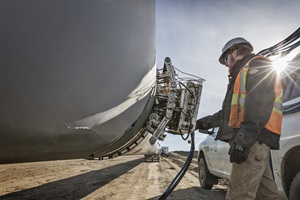Optimize Efficiency: Proactive Pipeline Welding Inspection Approaches
Comprehensive Overview of Pipe Welding Evaluation Procedures
In the realm of pipe building and construction, guaranteeing the stability and safety and security of welded joints is critical. Pipe welding evaluation procedures play a vital duty in ensuring that welded connections meet strict market standards and requirements. From meticulous pre-welding assessments to thorough post-weld assessments, a distinct assessment procedure is important for maintaining the structural sturdiness of pipes. Understanding the ins and outs of welding examination procedures is not only a regulatory requirement however additionally a fundamental facet of promoting the dependability of these crucial frameworks.
Pre-welding Inspection Preparations
Prior to commencing the welding process, extensive pre-welding examination preparations are vital to make certain the integrity and quality of the weld joint. These preparations involve a meticulous assessment of the materials to be welded, the welding equipment, and the work atmosphere. By carrying out complete pre-welding assessment prep work, prospective concerns can be determined and solved early on, leading to trusted and premium weld joints.
Welding Treatment Certification
Thorough pre-welding inspection preparations lay the foundation for the critical procedure of Welding Treatment Qualification, guaranteeing the integrity and high quality of the weld joint. Welding Procedure Qualification (WPQ) is a vital action in the welding procedure that involves testing and licensing welding treatments to assure they meet specific standards and demands. The WPQ procedure usually consists of welding procedure spec advancement, welding procedure credentials screening, and documents of the results.
During welding treatment spec development, important information such as the welding process, welding materials, joint layout, and welding specifications are specified to produce a thorough treatment. Subsequently, welding treatment credentials screening is carried out to validate the recommended treatment's honesty. This screening typically entails welding test coupons that go through various mechanical and non-destructive tests to assess the weld's top quality and adherence to the defined requirements.
In-process Weld Assessment
Throughout the welding process, in-process weld inspection plays a critical duty in ensuring the top quality and honesty of the weld joint - Pipeline Welding Inspection. This kind of examination entails keeping track of the welding specifications, examining the weld bead formation, and identifying any possible flaws or suspensions as they occur. By performing in-process weld evaluations, welding drivers can quickly address any concerns that may occur, consequently preventing further defects and ensuring that the final weld satisfies the called for requirements
Usual methods made use of for in-process weld inspection consist of visual evaluation, liquid penetrant testing, magnetic bit testing, ultrasonic testing, and radiographic screening. Aesthetic inspection is often the very first step while doing so, enabling examiners to aesthetically examine the weld for surface abnormalities such as splits, porosity, or insufficient blend. More innovative techniques like ultrasonic screening and radiographic testing give in-depth insights into the internal framework of the weld, making certain that there are no covert defects that might jeopardize the weld joint's toughness and stability. Generally, in-process weld assessment is crucial for keeping the top quality and dependability of bonded pipelines.
Non-destructive Screening (NDT)
Non-destructive Screening (NDT) is a critical method used in pipe welding evaluation to analyze the honesty of weld joints without causing damage to the bonded framework. By using various NDT techniques, assessors can examine the high quality of welds and recognize any kind of flaws or suspensions that might compromise the architectural soundness of the pipeline. Usual NDT techniques made use of in pipeline welding assessment include Radiographic Testing (RT), Ultrasonic Testing (UT), Magnetic Particle Testing (MPT), Fluid Penetrant Screening (LPT), and Visual Testing (VT)
RT entails using X-rays or gamma rays to create pictures of the interior framework of the weld, enabling assessors to detect defects such as porosity, fractures, or incomplete combination. UT uses high-frequency sound waves to find defects beneath the surface area of the weld, offering in-depth info about the dimension and area of issues. MPT and LPT are utilized to determine surface-breaking problems by applying penetrant liquids or magnetic particles to directory the weld location. informative post Additionally, VT entails visual inspection of welds to recognize any type of noticeable blemishes.
Post-weld Evaluation and Documents
Paperwork of post-weld examination findings is vital for keeping quality assurance documents and guaranteeing compliance with market standards and policies. Comprehensive records must include information about the assessment methods utilized, the area and nature of any type of problems discovered, and any restorative actions taken - Pipeline Welding Inspection. Appropriate documents not only acts as a document of the weld's quality however additionally help in future upkeep and evaluation procedures
Verdict

Finally, pipe welding assessment procedures play a crucial duty in guaranteeing the top quality and stability of welds. From pre-welding examinations to post-weld documentation, each action is necessary in keeping the safety and security and efficiency of pipelines. By complying with well established procedures and conducting complete inspections, possible defects can be recognized and dealt with before they result in pricey repair work or failures. Overall, adherence to appropriate evaluation procedures is key to the success of pipe welding projects.
From thorough pre-welding assessments to thorough post-weld evaluations, a distinct inspection process is essential for visit site maintaining the architectural strength of pipelines. By conducting in-process weld examinations, welding drivers can quickly deal with any issues that may emerge, thus avoiding additional problems and making certain that the final weld meets the needed requirements.
Common methods made use of for in-process weld assessment consist of visual inspection, fluid penetrant screening, magnetic fragment testing, ultrasonic testing, and radiographic screening.Non-destructive Testing (NDT) is an important method used in pipe welding inspection to analyze the stability of weld joints without triggering damage to the bonded framework. Post-weld evaluation entails different approaches to assess the welds for flaws, including visual examination, color penetrant testing, magnetic bit screening, ultrasonic testing, and radiographic testing.